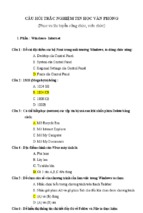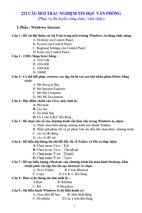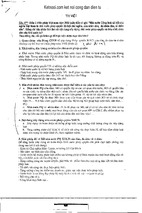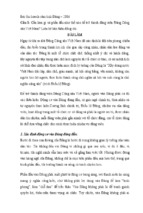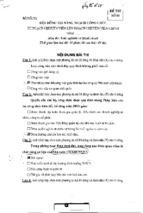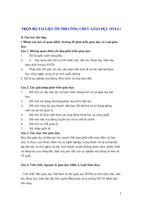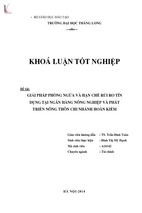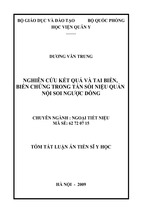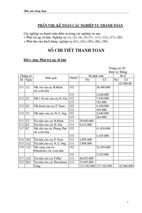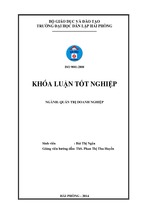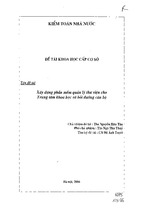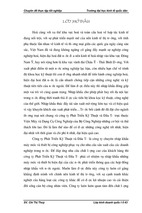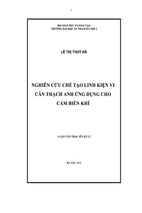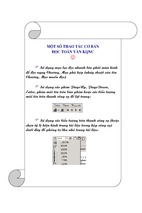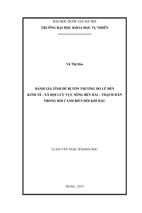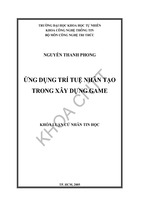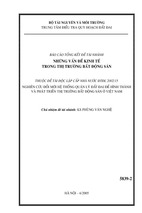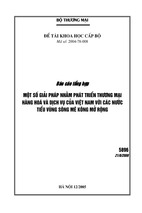OI
o
•.
s ơ GIAO DUC VA ĐAO TAO HÀ NÔI
GIÁO TRÌNH
Tiéng
Anh
chuyên ngành tin học
Englishtor Computing
DUNG TRONG CÁC TRƯƠNG TRUNG HOC CHUYÊN NGHIÊP
±
♦
IHÀ XUẤT B í
\1
ANỘI
Ể K Ế Ể ' í
SỞ GIÁO DỤC VÀ ĐÀO TẠO HÀ NỘI
NGUYỄN THỊ VÂN «Chủ biên)
TRẦN THỊ PHƯƠNG MAI
GIÁO TRÌNH
TIẾNG ANH
CHUYÊN NGÀNH TIN HỌC
ENGLISH FOR COMPUTING
(Dùng trong các trường THCN)
NHÀ XUẤT BẢN HÀ NỘI - 2007
Lời giới thiệu
A 7 ước ta đang bước vào thời kỳ công nghiệp hóa, hiện
1
V đại hóa nhằm đưa Việt Nam trở thành nước công
nghiệp văn minh, hiện đại.
Trong sự nghiệp cách mạng to lớn đó, công tác dào tạo
nhân lực luôn giữ vai trô quan trọng. Báo cáo Chính trị của
Ban Chấp hành Trung ương Đảng Cộng sán Việt Nam tại
Đại hội Đàng toàn quốc lần thứ IX dã chỉ rõ: “Phát triển
giáo dục và đào tạo là một trong những động lực quan trọng
thúc đẩy sự nghiệp công nghiệp hỏa, hiện đại hóa, là điều
kiện để phát triển nguồn lực con người - yếu tố cơ bản để
phát triển xã hội, tăng trưởng kinh tế nhanh và bền vững”.
Quán triệt chủ trương, Nghị quyết của Đảng và Nlìà nước
và nhận thức đúng đơn về tầm quan trọng của chương trình,
Sịicio trình đối với việc nâng cao chất lượng đào tạo, theo d ề
nghị của Sở Giáo dục và Đào tạo Hà Nội, ngày 23/9/2003,
Úy ban nhân dân thành p h ố Hà Nội dã rơ Quyết đinh số
5620/QĐ-UB cho phép Sở Giáo dục và Đào tạo thực hiện đề
án biên soạn chương trình, giáo trình trong các trường Trung
học chuyên nghiệp (THCN) Hà Nội. Quyết định này th ể hiện
sự quan tâm sâu sắc của Thành ủy, UBND thành p h ố trong
việc nâng cao chất lượiĩg đào tạo và phát triển nguồn nhân
lực Thủ đô.
Trên cơ sở chương trình khung của Bộ Giáo dục và Đào
tạo bơn lĩành và những kinh nghiệm rút ra từ thực tè'dào tạo,
Sở Giáo dục và Đào tạo đã chỉ đạo các trường TH C N rổ chức
biên soạn chương trình, giáo trình một cách khoa học, hệ
thống và cập nhật những kiến thức thực tiễn phù hợp với dối
tượng học sinh THCN Hà Nội.
Bộ giáo trình này là tài liệu giang dạy và học tập trong
các trường THCN ở Hù Nội, dồng thời là tài liệu tham kháo
hữu ích cho các trường có đào tạo các ngành kỹ thuật - nghiệp
vụ và đông đáo bạn đọc quan tâm đến vấn để hướng nghiệp,
dạy nghề.
Việc tổ chức biên soạn bộ chương trình, giáo trình này
lả một trong nhiều hoạt động thiết thực của ngành giáo dục
và đào tạo Thủ đô đ ể kỷ niệm “50 năm giải phóng Thủ đô ”,
“SO năm thành lập ngành ” và hướng tới kỷ niệm “1000 núm
Thăng Long - Hà N ộ i”.
Sở Giáo dục và Đào tạo Hù Nội chân thành cám ơn Thành
ủy, UBND, các sở, ban, ngành của Thành phố, Vụ Giáo dục
chuyên nghiệp Bộ Giáo dục vả Đào tạo, các nhà khoa học, các
chuyên gia đầu ngành, các giáng viên, các nhà quán lý, các
nhà doanh nghiệp đã tạo điều kiện giúp đỡ, đóng góp ỷ kiến,
tham gia Hội dồng phản biện, Hội đồng thẩm định và Hội
đồng nghiệm thu các chương trình, giáo trình.
Đây là lần đầu tiên Sở Giáo dục và Đào tạo Hà N ội tổ
chức biên soạn chương trình, giáo trình. Dù đã hết sức c ố
gắng nhưng chắc chắn không tránh khỏi thiếu sót, bất cập.
Chúng tôi mong nhận dược những ỷ kiến dóng góp của bạn
đọc đ ể từng bước hoàn thiện bộ giáo trình trong các lần tái
bấn sau.
GIÁ M ĐỐ C SỞ G IÁ O D Ụ C VÀ Đ À O T Ạ O
4
INTRODUCTION
A im s o f the course
English for computer is a course book in English designed for students
who are learning course on computing application. The book covers the four
language skills of listening, speaking, reading and writing, as well as
improving pronunciation and building vocabulary. Particular emphasis is
placed on reading. The primary goal of the course is to provide grammatical
knowledge, some technical terms, words belonging to the computing area, that
is, to better the students' ability to use the language according to the
professional situations and apply to practical job.
Course length
The course contains 180 classes in the two last semesters in the college. There
are 75 theoretical classes, 95 practical classes and 10 tests for the whole course.
The content o f the course
The book is divided into 15 main units and 3 review units. Each main unit
focuses on a topic related to a professional situation and follows the same
teaching sequence.
1. S tructure of a main unit
Presentation includes suggested questions aiming to provide useful
information involved in the topic given in the unit and to develop vocabulary as
well as speaking skill.
Language Study The new grammar of each unit is presented and is
followed by practice activities. Different kinds of exercises for speaking and
grammatical drills such as pair work, group work, or role-play provide more
opportunity for student practice of the new language items that have just been
presented.
Vocabulary develops students' vocabulary through a variety of interesting
tasks, such as word map and collocation exercises. Vocabulary activities are
usually followed by written or oral practice that helps students understand how
to use the vocabulary in context.
Listening the listening activities develop a wide variety of listening skills,
including listening for gist,’ listening for details and inferring meaning from
context. Charts or graphics are often accompany red with these task-base
exercises to lend support to students.
Speaking teaches students how to present an issue. Speaking tasks involve
the use of the new structures and words at the same time concentrate on the
topic of the unit.
Reading the reading has two parts: a text and introduction to different
kinds of computer and their component. The Readings develop a variety of
reading skills, including reading for details, skimming, scanning and making
inferences. Sometimes included are pre-reading and post-reading questions in
which the topic of the reading is used as a springboard to discussion.
W riting the writing exercises include practical writing tasks that extent and
reinforce the teaching points in the unit and help develop students' writing skills.
2. Review units
The review units consolidate the students' knowledge learned from four
previous units with a variety of practical exercises.
Keys, wordlist and appendix are at the back of the book as the reference for
teacher; and students.
77/r method o f study
English fo r com puter teaches students how to use English for very popular
professional situations. Students are provided with useful language from the
course book. In addition, students have the opportunity to personalize the
language they have learnt, make use of their own language and experiences
and express their ideas and opinions. In order to learn the most effectively,
students must be hard-working, active, try to read more references and to
memorize vocabulary as well. Outside the classroom practice is also a good
method learning.
6
S e c tio n 1
COMPUTERS
Unit 1
WHAT IS A COMPUTER?
Objectives
- Understand and know how to use words and expression related to
computer
- Can use the passive form well.
- Can describe a computer system by using words , expressions and
grammartical structures.
Contents
8
Reading:
Read about some background of computer.
L iste n in g :
Listen to people talking about how they use
computers at work
Speaking :
Discuss how computers are used at home,
outside work
W riting :
Complete a paragraph about computer uses.
Language study
The passive
WARM UP ACTIVITY
In pairs, label the elements o f this computer system. Then read the text
to check your answer.
k
6»'; i t t-'k.
»-pfti * 1
t'i t i ï m '■*
^]
f n i r r t i t t ¡»*1 i b i U « « *
p ? ? i t t rm t
* t ? *» % > ¿ ;
.* .* *: f *f s W f fc t-_ ir b * *»{39 5i S V ?
•
‘
ü
a-
ca? x fc i î m
*
READING
/?earf f/ie follow ing text and do the exercise.
A computer is a machine with an intricate network of electronic circuits that
operate switches or magnetize tiny metal cores. The switches, like the cores, are
capable of being in one of two possible states, that is, on or off; magnetized or
demagnetized. The machine is capable of storing and manipulating number,
letters, and characters. The basic idea of a computer is that we can make the
machine do what we want by inputting signals that turn certain switches on and
turn others off, or that magnetize or do not magnetize the cores.
The basic job of computer is the processing of information. Three basic
steps are involved in the process. First, data is fed into the com puter’s
memory. Then,
when the program is run, the computer performs a set of
instructions and processes the data. Finally, we can see the results (the
output) on the screen or in printed form. Information in the form of data and
programs is known as softw are, and the electronic and mechanical parts that
make up a computer system are called hardw are.
Computers have many remarkable powers. However, most computers,
whether large or small have three basic capabilities. First, computer has circuits
for performing arithmetic operations, such as: addition, subtraction, division,
multiplication and exponentiation. Second, computer has a means of
communicating with the user. After all, if we couldn’t feed information in and
get results back, these machines wouldn’t be of much use. However, certain
computer (commonly minicomputers and microcomputers ) are used to control
directly things such as robots, aircraft navigation systems, medical instruments,
etc. A standard computer system consists of three "main sections: The centre
processing unit (C PU ), the main memory and the peripherals.
Task 1
Decide whether the follow ing statements are true or fa lse (T/F) by
referring to the inform ation in the text. Then make the necessary changes so
that the fa lse statem ent becomes true.
information to do so.
10
f
2. All computers accept and process information in the form of instructions
and characters.
3. The information necessary for solving problems is found in the memory
of the computer.
4. Not all computers can perform arithmetic operations, make decisions
and communicate in some ways with the user.
5. Computers can still be useful machines even if they can’t communicate
with the user.
6. There are many different devices used for feeding information into a
computer.
7. There aren’t as many different types of devices used for giving results
as there are for accepting information.
8. Computers can make any type of decision they are asked to.
9. Computers can work endlessly without having to stop to rest unless
there is a breakdown.
LISTENING AND WRITING
Task 2
Before listening, answer these questions
1. Have you got a computer at home,
school or work? What kind is it?
2. How often do you use it? What do
you use it for?
Task 3
Listen to these people talking about how they use com puters at work and
write each speaker's jo b in the table.
Electrical engineer
librarian
Speaker
Job
secretary
com poser
W hat they use com puter f o r
1
2
3
4
Task 4
Now listen again and write what each speaker uses their com puter fo r.
SPEAKING
Task 5
The article states that ‘m any computers in people's hom es are ju s t used
to play com puter g a m es'. Discuss the follow ing questions:
12
WRITING
Task 6
V f~o( ,v 7''
M atch the places in column A with the computer uses in colum n B.
A
Banks
Factories
Homes "
Hospitals
Shops
"
B
control machines o
calculate the bill
~f
>
Ilook after patient records and medicine
provide entertainment and information
control our money
Task 7
Now read the paragraph and use the phrases in colum n B to f ill in the
gaps.
Computers are now part of our everyday life. In shops, they (1) ...............
In factories, they ( 2 ) ........................................ In ( 3 ) ..........................................they
look after patient records and medicines. When we have a bank account, a
computer ( 4 ) ..................... In our homes, computers ( 5 ) .................................
LANGUAGE STUDY
The passive
Passives are very common in technical writing where we are more
interested in facts, processes, and events than in people. We form the
passive by using the appropriate tenses of the verb to be followed by the
past participle of the verb we are using.
Exam ples
Active
1. We sell computers, (simple present)
2. Babbage invented ‘ The Analytical Engine’, (simple past)
Passive
1
Computers a re sold
2
“The Analytical Engine” was invented in 1830.
■
■ ■
■■ -
u
\
-
j
13
Task 8
Read the text below, which describes the insurance com pany's
procedure fo r dealing with PC-users' problems. Fill in the gaps using the
correct fo rm o f the verb in brackets.
All c a lls .............. are registered................. (register) by the Help Desk staff.
Each c a l l ............ 2 ........... (evaluate) and th e n ................. 3 .............. (allocate) to
the relevant support group. If a visit ..................... 4 ..................... (require) , the
user ..................5 ................ (contact) by telephone, and an appointment
................. 6 .................. (arrange) . Most c a lls .................. 7 ................. (deal with)
within one working day. In the event of the major problem requiring the
removal of a user’s PC, a replacement can u su a lly .................8 .............. (supply).
Task 9
Fill in the gaps in the follow ing sentences using the appropriate fo rm o f
the verb in brackets.
1 The part of the processor which controls data transfers between the
various input and output devices
.......... (call) the control unit.
2 The address bus ...J.LUAid.......................... (use) to send address details
between the memory and the address register.
3 The pixel positions ...................... (pass on) to the com puter’s
pattern recognition software.
4 An operating system ..Js.MOA.U...................(store) on disk.
5 Instructions written in a high-level language................................................
(transform) into machine code.
6 In the star configuration, all processing and control fu n ctio n s..................
(perform) by the central computer
7 When a document arrives in the mail room, the en velope.................i.....
(open) by a machine.
8 Once the index
.................. (store) , a temporary key number
...................(generate) and
.................. (write) on the document.
Task 10
Fill in the gaps in the follow ing sentences using the appropriate fo r m o f
the verb in brackets.
1. Microsoft was founded (found) by Bill Gates.
14
2. C language
(develop) in the 1970s.
3. During the period, enormous advances ....HhnJ.L
computer technology.
(s e ll).
4. The following year, twice as many PCs
(set up) in
5. In the 1980s, at least 100.000 LANs ...
laboratories and offices around the world.
6. The first digital computer
Pennsylvania in 1946.
(make) in
........(build) by the University of
7. Last year, more software companies .... .................................. (launch)
than ever before.
8. IBM’s decision not to continue manufacturing m ainfram es.......................
(reverse) the year after i t ........................(take).
PRACTICE
Task 11
Fill in each blank with the appropriate fo rm o f the words
W
?.
7. operation, operate, operator, operational, operationally, operating
a. A computer can perform arithmetical
very quickly.
b. One of the first person to note that the computer is malfunctioning is the
computer
............
c. The job of a computer operator is t o
machines in a computer installation.
. . ................... the various
15
d. The new machines in the computer installation are not yet..1.1
2. acceptable, accept, acceptance , accepted, acceptably
a. A computer is a device w h ic h ..............................processes and gives out
information.
b. The students are still waiting for their ............. ................
into the
Computer Science program.
c. It \s...C.!x .:il’.iCii-k.......to work without a template if the flowcharts are not
kept on file.
3. solution
solve
solvable
solver
a. It may take a lot of time to find a....... ....................... to a complex problem
in programming.
b. A computer can...1.1.,.!..................a problem faster than any human
being.
c. A computer has often been referred to as a problem ...................
4. remark
remarkable
remarkably
remarked
a. Today’s computers a r e ..............................faster than their preescessors.
b. System
analysts
will
often
m ake.............................. about
existing
programs so as to help make the operations more efficient
c. There have been............. ................ developments in the field of computer
science in the last decade.
5. communication
communicate
communicative
communicable
communicably
a. A computer must be able to.............................. with the user.
b. Fiber optics is a new development in the field of.............................
c. Some
people
working
in
computer
installations
aren’t
very..............................because they are shy
Task 12
Fill in the gaps in this paragraph with a/ an or the where necessary.
The Walsh family have .............................. computer at home. Their son
uses ............................... computer to he|p with..................................... homework
16
and to play..............................
computer games. Their students daughter
uses..............................computer
for
..............................projects
..............................email.
All..............................family
use
and
it
for
to
get............... information from.............................. Internet.
Data
Processing
Result
On the monitor
Or in printed form
Task 13
Use the inform ation in the text and the diagram to help you match
the terms in the box with the appropriate explanation or definition below
software
peripheral devices
floppy disk
hardware
input
port
output
center
processing
unit
1. The brain of the computer.
- Xem thêm -


